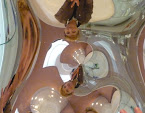 My Lightweight Intentions was first published in Cambridge, U.K. by John Kinsella's imprint Folio (Salt) in 1998. Never-Never Books reprints this 23 page C5 sized chapbook of poems from the late 1990s with a cover photo that I took in the Graffiti Tunnel at Sydney University in late February this year. Here's a sample poem.
My Lightweight Intentions was first published in Cambridge, U.K. by John Kinsella's imprint Folio (Salt) in 1998. Never-Never Books reprints this 23 page C5 sized chapbook of poems from the late 1990s with a cover photo that I took in the Graffiti Tunnel at Sydney University in late February this year. Here's a sample poem. This & That
(I cite myself)
Resting like a relic
in a field of meaning -
push the rocks around
for transformation -
gravel rash, scab, scar,
all
factors that
fall squarely.
(like that)
those well-known codes -
public-private continuum -
a surveyor's tripod clacks -
the laneway, reduced
& framed,
is picturesque -
even the rubbish
appears artificial.
casual citations
accumulate,
ballooning
empirical tactics -
o no it's
an index of anecdote
the hypermarket
surveillance camera
attempts its capture -
my nearly-beautiful
every dream,
my artificial memory
daily.
disease, elusive entity,
slithers.
pale gloved hands,
yet HIV negative.
the milky
ampoule's contents
swallowed -
waste management, the nightclub.
sleepless in a townhouse,
hours of
zonelessness.
(like this)
 Peel Me A Zibibbo is a group of recent poems - five poems written for friends. It's a 14 page C5 sized chapbook. Here's the title poem -
Peel Me A Zibibbo is a group of recent poems - five poems written for friends. It's a 14 page C5 sized chapbook. Here's the title poem - Peel me a zibibbo
I could go
in any direction
but it's best that here and now
I remain lesbian,
keep my vanishing cream
sealed.
I'll go south
eventually
to follow the sheen
of your signals,
in the meantime
my problem's like how to
design a wall didact -
serif or not's
a big decision
*
it's October so
the bogong moths
are back
and the koels - the October
crack of dawn racket -
are back again too,
mauve jacaranda petals
are stuck
on the windscreen wipers rubber
*
by now the wall text task
is impossible -
application decreasing,
attention span diminishing -
transparency an aim,
how coded the coding
*
imperfection in kindness
comes with the void,
you need to
choose
the 'I'm feeling lucky' google option
*
drinking in the cemetery
sounds like an early
Nick Cave song
but it's
something-to-do,
it's also the subject
of Paddy Fordham's
drawing
*
should I start carrying
my books
in clear plastic bags
inside
my polyester document bag,
is this a solution ?
16° centigrade
95% humidity
what a precipitate place
*
shouting Shakespeare aloud
to the sea
in Surfers' Paradise
in 1964
after hurling your body down
fine off-white sand dunes.
now it's 2006
you're experiencing thanatos
high up on a Seidler balcony.
if you are in doubt
(slurp over drinks)
what gives the false poet
such confidence ?
*
awake and refreshed
tho with nothing on the page
*
John T phones -
this cloudy gloomy
early summer day
is 'like the fifties' he says.
every day ?
miserable childhood ?
photographic weather memory
à la recherche du temps inclément
*
I was reading
about the sweet potato farmers
of Osaka
living such long lives -
nonogenarians, centogenarians -
when Kurt called in with his new book
Hyper Taiwan
Taiwan - it's 'sweet potato island'
hi Kurt, hi John T,
hi Nick, Paddy, hi Shakespeare,
peel me a zibibbo
would you,
one of you guys ?
Never-Never Books PO Box 55 Rose Bay NSW 2029 Australia
 This issue of Meanjin magazine - Blak Times has been edited by Peter Minter, poet and lecturer at the Sydney University Koori Centre. It is chock full of apposite, informative and powerful essays, interviews, stories and poems by and about Australian Indigenous writers, visual artists, critics and musicians. It has a sixteen page, full colour spread of artworks and stills from recent films.
This issue of Meanjin magazine - Blak Times has been edited by Peter Minter, poet and lecturer at the Sydney University Koori Centre. It is chock full of apposite, informative and powerful essays, interviews, stories and poems by and about Australian Indigenous writers, visual artists, critics and musicians. It has a sixteen page, full colour spread of artworks and stills from recent films.



























